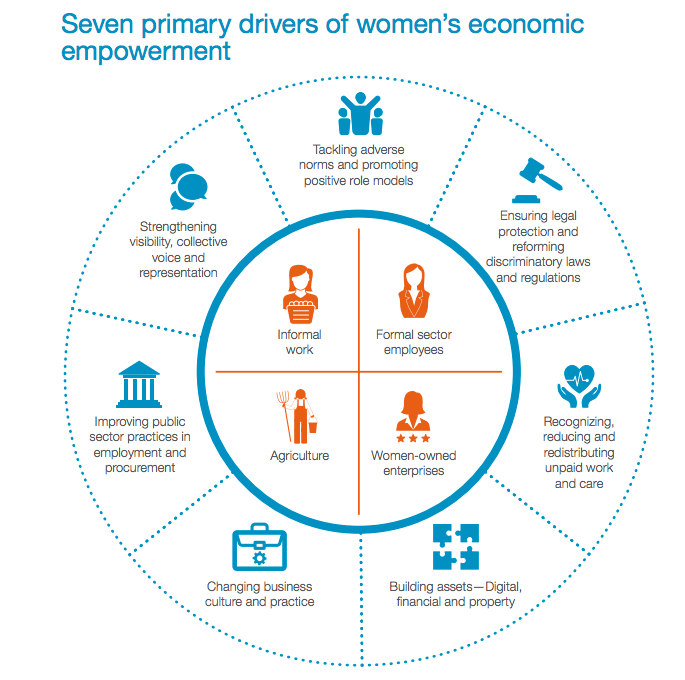Editor’s Choice, September 2017: Second report of the UN High Level Panel on Women’s Economic Empowerment
Do business people, even inclusive business practitioners, often read reports of United Nations High Level Panels? I'm not sure. But the second report of the UN High Level Panel on Women's Economic Empowerment is worth your time if you want to know:
- what women's economic empowerment is all about (in a 'wheel' graphic) and why it matters for putting global development on a sound footing;
- the top 'asks' for business practice changes that empower women (in a page and a half);
- how the role of business in driving women's economic empowerment fits into the wider picture, including role of government, legal systems, social norms, and economics.
The High-Level Panel, formally convened in March 2016, released its first report, ‘Leave No One Behind: A Call to Action for Gender Equality and Women’s Economic Empowerment’, at the UN General Assembly in September 2016. The first report laid out evidence for an urgent effort. This second report, published this year, goes in more depth as to what needs to be done. The cross-sector panel is chaired by the CEO of IKEA Switzerland and President of Costa Rica.
Women's Economic Empowerment is a challenging term, with an acronym that is worse (WEE). The framework used by the panel is increasingly common currency, and a useful way to think of the four broad 'categories' of economic woman (informal worker, formal sector worker, smallholder, and entrepreneur) and multiple dimensions on which change is needed. Change in business practice is one of these seven, but clearly has a strong influence on others, such as how women's digital, physical and financial assets are built, their legal protection, and role models.

Leaving these overlaps aside for a minute, the High-Level Panel prioritises 4 'asks' of business:
- Conduct an internal self-audit (on pay, employment, leadership, CSR and supplier engagement).
- Incentivize frontline management to set and meet targets for gender inclusion.
- Set procurement targets for sourcing from women-owned enterprises.
- Map value chains to ensure ethical sourcing and workers’ rights.
You will spot quickly that these asks are most relevant to corporates, or at least to more established businesses that have CSR, procurement strategies and reach into value chains. But for those types of businesses, these are good deep asks. And a very good place to start.
The report also makes the business case for action, again well summarised in a diagram:

This resonates with last month's Editor's Choice, the report of the Commission for Better Business, which made a compelling business case for action, though without gender specific attention.
There are two more things I particularly like about this report for business readers, aside from the synthesis graphics. And two that I don't.
Firstly, we too often focus on what business alone can do, rather than on how better business models interact with wider change. This report places business action alongside action on social norms, legal rights and more.
Secondly, it combines both practical and fundamental perspectives. It does not shy away from the tough issues and the ethical stance: women's economic empowerment requires changes in social norms, in the distribution of unpaid care, and recognition of women's rights. It is a long-term agenda, needing partnership and change. Yes, you are right I hear the voice of development actors and civil society here (declaration of interest: Oxfam was an active contributor and participant, and I now work for Oxfam). But it is not an NGO monologue, nor one of those fuzzy wish lists. It has boiled its recommendations down into 7 key areas, with one to three recommendations in each, through a process of prioritisation across government, private sector, UN and civil society interests. Each recommendation is ambitious. But makes sense and is concisely covered.
So, onto my reservations. Firstly, the role of business in delivering the other 6 drivers are easily missed. Respect for rights to organise and collective bargaining, ensure women’s progress in digital inclusion, supporting the informal sector, respecting legal rights.... all these are matters for business as well as government. Even social norms about women's roles can be challenged by business - after all, they are the ones with the marketing skills and budgets. It is too easy to walk away with only the four main asks of business listed under the 'role of business' heading, and miss the rest.
Secondly, I feel something bigger missing. It calls for changes in specific business practices, but not in the financial investment patterns that drive business. As we see from this month's blog series on women and inclusive business, shifts among investors are a key part of shifting business change. Shifts in practice of corporates would be great, but would ideally be part of a bigger shift in business models, encompassing social enterprises, new assumptions and rules about combining impact and profit. I think many of us in the inclusive business space feel that we are part of a bigger momentum of change in economic models, and it would be good to have UN High Level Panels raise the bar perhaps even higher, to call for that.
Further information
- Find more resources on WEE & inclusive business on searchable publications database SearchIB
- Read more reviews of resources on inclusive business in our Editor’s Choice section.
This blog is a part of the September 2017 series on Empowering women, in partnership with SPRING.
Read the full series for insights on business models that empower girls and women, a new analysis of gender impacts of value chain interventions, tips on gender-lens investing and many inspiring personal stories from women.